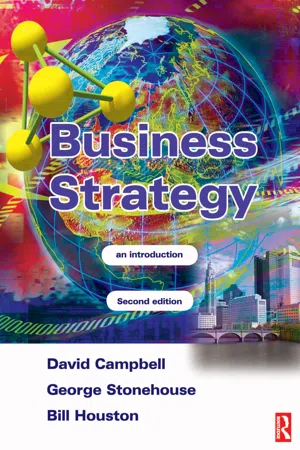Economics
Market Size
Market size refers to the total sales or revenue generated within a specific market over a defined period. It is a key metric for understanding the potential for growth and profitability within a given industry or sector. Analyzing market size helps businesses make informed decisions about resource allocation, target audience, and market expansion strategies.
Written by Perlego with AI-assistance
Related key terms
1 of 4
Related key terms
1 of 3
4 Key excerpts on "Market Size"
- eBook - ePub
Strategic Marketing
An Introduction
- Tony Proctor(Author)
- 2002(Publication Date)
- Routledge(Publisher)
Trying to understand the key factors which govern a firm’s success are very important. This moves us on from simply looking at the profitability of a market to consideration of cost structures, distribution systems and related trends and developments.DIMENSIONS OF MARKET ANALYSIS
This varies somewhat according to the context. However, the following are often included:- • actual and potential Market Size
- • market growth
- • market profitability
- • cost structure
- • distribution systems
- • trends and developments
- • key success factors.
Figure 5.1 Market analysisACTUAL AND POTENTIAL Market Size
A starting point is always the level of sales. Estimates of Market Size can be based on government sources or trade association findings. Another approach is to obtain information on competitors’ sales from published financial sources, customers or even competitors. Still another, though more expensive option, is to survey customers and project their usage to the total market.The potential market is also of interest. A new use, new user group or more frequent usage could change dramatically the size and prospects for the market.MARKET GROWTH
After the size of the market and its important sub-markets have been estimated, the focus turns to estimating trends in growth rates or decline rates.Identifying Driving Forces
Often the most important strategic question involves the prediction of market sales and identifying the factors that will drive sales directly or indirectly.Forecasting Growth
Defining Market Demand
Demand can be measured at several levels:- • product levels—product item sales, product form sales, product line sales, company sales, industry sales, national sales
- • space levels—sales to individual customers, sales by territory, area or country, world sales
- • time levels—short-range, medium-range, long-range sales.
There are ‘penetrated markets’, ‘potential markets’, ‘available markets’ and ‘served markets’. The current number of users of a product or service and the sales volume they generate constitutes the ‘penetrated market’. There may be figures readily available which indicate this or it may be necessary to establish it by sample survey. - eBook - ePub
The Business Models Handbook
Templates, Theory and Case Studies
- Paul Hague(Author)
- 2019(Publication Date)
- Kogan Page(Publisher)
25Market sizing
Assessing the size and value of a served or potential marketWhat the model looks like and how it works
Marketing strategies need to be based on a good understanding of the Market Size. The starting point has to be the definition of the market. There are two measures of Market Size – the total available market (TAM) and the served available market (SAM). The SAM is that which a company supplies with its products and in which it competes against other companies producing similar products. The TAM is wider and includes competitive and substitute products.A supplier of instant coffee would define its SAM as the market for instant coffee as supplied by the company itself and other competitors. The TAM for instant coffee could be widened to include the market for fresh ground coffee and even the market for substitute beverages such as hot chocolate, tea, etc. The TAM is not necessarily a pushover. Someone wanting instant coffee will only move outside of that closely defined need and into the wider market if instant coffee is not available or if they fancy a change of taste. We need to be aware of these definitions of Market Size before setting out on the calculation.Market Size estimations are required for strategic planning purposes (Table 25.1 ).The Market Size figure alone will not answer the strategic questions. It will also be necessary to understand the channels to market, the levels of competition, customer loyalty, prices, etc.Table 25.1 Market SizeMarket Size solves these strategic questions… By answering these specific questions… - Should we invest in this product/market?
- Should we increase our investment in this product/market?
- Should we decrease our investment in this product/market?
- Is the market big enough to interest us?
- Is the market moving in the right direction?
- Is the market moving fast enough?
- Is the market profitable enough?
SOURCE B2B International (2014) - eBook - ePub
- George Stonehouse, Bill Houston(Authors)
- 2003(Publication Date)
- Routledge(Publisher)
Economists refer to a market as a system comprising two ‘sides’. The demand side comprises buyers or consumers of a product or resource; the supply side produces or manufactures the same.In strategy, we often use the term slightly differently. By market, we usually mean a group of actual or potential customers with similar needs or wants (the demand side). We usually refer to the supply side as an industry.The definition and boundaries of an organization's markets represent a key starting point for the formulation of strategy, and provide a basis for measuring competitive performance. The analysis and definition of markets will provide key information concerning threats and opportunities.Market share is a measure of an organization's performance with regard to its ability to win and retain customers. It can be measured either by volume or by value. Volume measures concern the organization's share of units sold to the market (e.g. number of barrels of oil sold by an oil company in proportion to the total number of barrels sold). Value measures concern the sales turnover of one company in proportion to the total value of the market.We can also define the boundaries of markets in different ways. If different companies define a market in different ways, it is not surprising that the sum of their claimed market share may add to more or less than 100%. The grocery market, for example, may mean different things to different companies. One might include just the English market for groceries, whereas another might measure it for the whole of the UK. It is clearly important, therefore, that market share measures are stated explicitly with the market boundaries clearly defined. - John Winkler(Author)
- 2014(Publication Date)
- Routledge(Publisher)
Taking the key products in the business—those which earn the bulk of the company’s profit contribution—the marketing man will want to know what the user thinks of those products and how good he finds them compared with competitors’ products. This calls for objective product testing.Next he will want to know the size of the market which the company’s main products serve. Market Sizes are calculated in one of two ways, either in sterling cash value, being the amount spent on the product by the customers in a year, or in consumption, being the tonnage or number of units consumed in a year. Once the Market Size has been established it will be necessary to know what share of the market is held by main competitors. So far this is straightforward market research. But so many companies—particularly smaller ones—obtain this information and then leave it at that. The most important part of the information is yet to come. Markets are dynamic, that is to say the patterns of trade are changing, and particularly is this true of the developing market. So it is necessary to have information on competitive shares of the market taken over a period of time to see who is doing better and who is doing worse than his rivals. A detailed analysis of market growth or decline within a company’s trading area is vital information needed over a period of time. Without it a company is shooting in the dark.Measuring product performance
Every company, large and small, needs to know its own product strength and product weakness in the eyes of the user. Technically a product may be the finest example of engineering skill that ever was seen; in the eyes of the technologist it may be a credit to him. But what matters is not his view but the view of the consumer. If a consumer recognises a product’s advantages and wants them, so much the better. But so often the consumer is blind to technical perfection and will be willing to make do with a cheaper competitive product. Where this happens each company must recognise that the competitive product is serving the consumer’s ‘need’ better than competitors.Many products are tested in a firm’s laboratory against competitors by a form of management jury panel. On such a panel senior executives gather round and criticise each of the competitors’ products in turn. This is a suitable device for getting management to know about competitors’ products. But as an objective product-testing system it is often useless. There are a number of reasons why such a panel cannot be used to test products, other than to compare their physical characteristics such as weight, size, shape, height, and so on. For a start the jury panel is not a proper sample. It is not gathered together in a statistically valid form; it is not large enough and its members are biased by the fact that they are experts and not ordinary buyers. Secondly, there is often no formal questionnaire and the opinion of the group often follows the line taken by the senior member of the group, few being willing to argue openly with, say, the managing director. Last, the sample of products shown is not usually a statistically valid sample of those that are produced. Such a group cannot be emotionally objective about competitors’ products. The entire lives, dreams, and ambitions of the individual group members are wrapped up in the products they make, and the competitor is the enemy.
Index pages curate the most relevant extracts from our library of academic textbooks. They’ve been created using an in-house natural language model (NLM), each adding context and meaning to key research topics.
Explore more topic indexes
Explore more topic indexes
1 of 6
Explore more topic indexes
1 of 4



